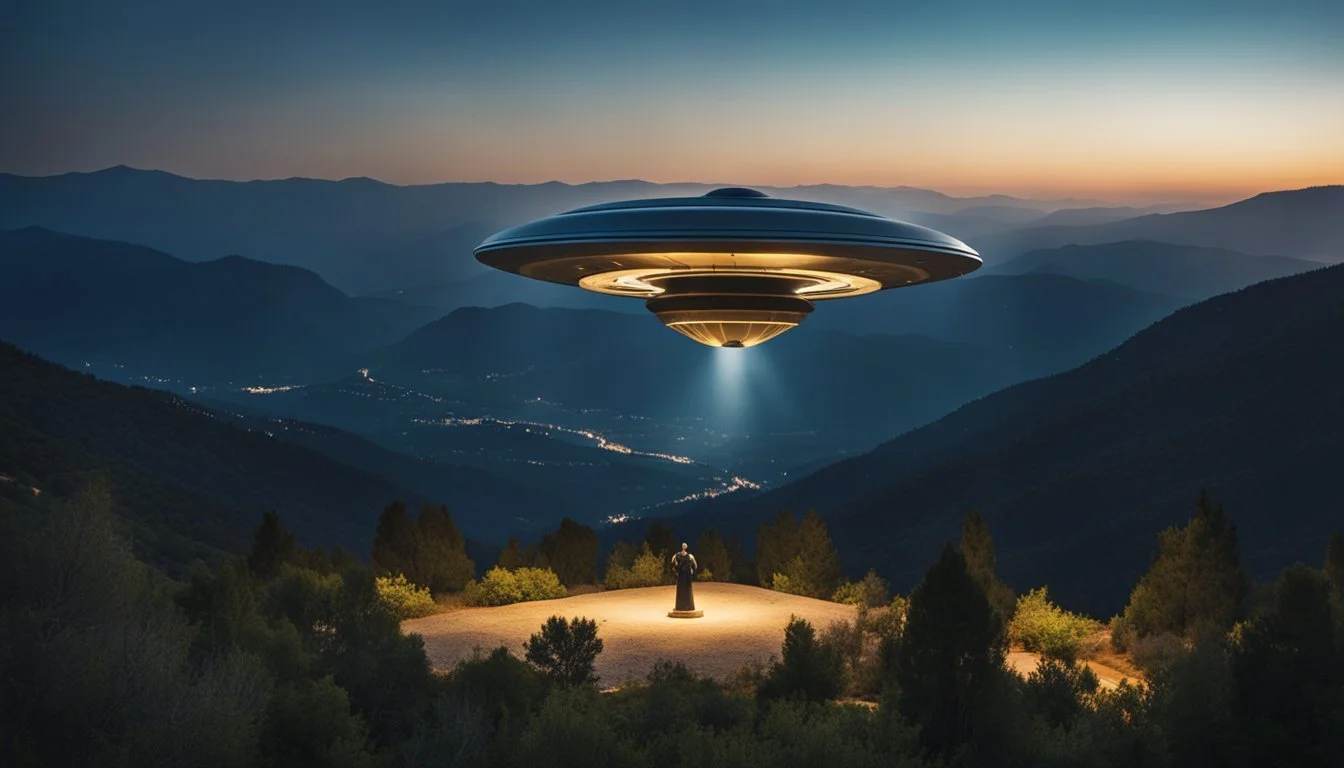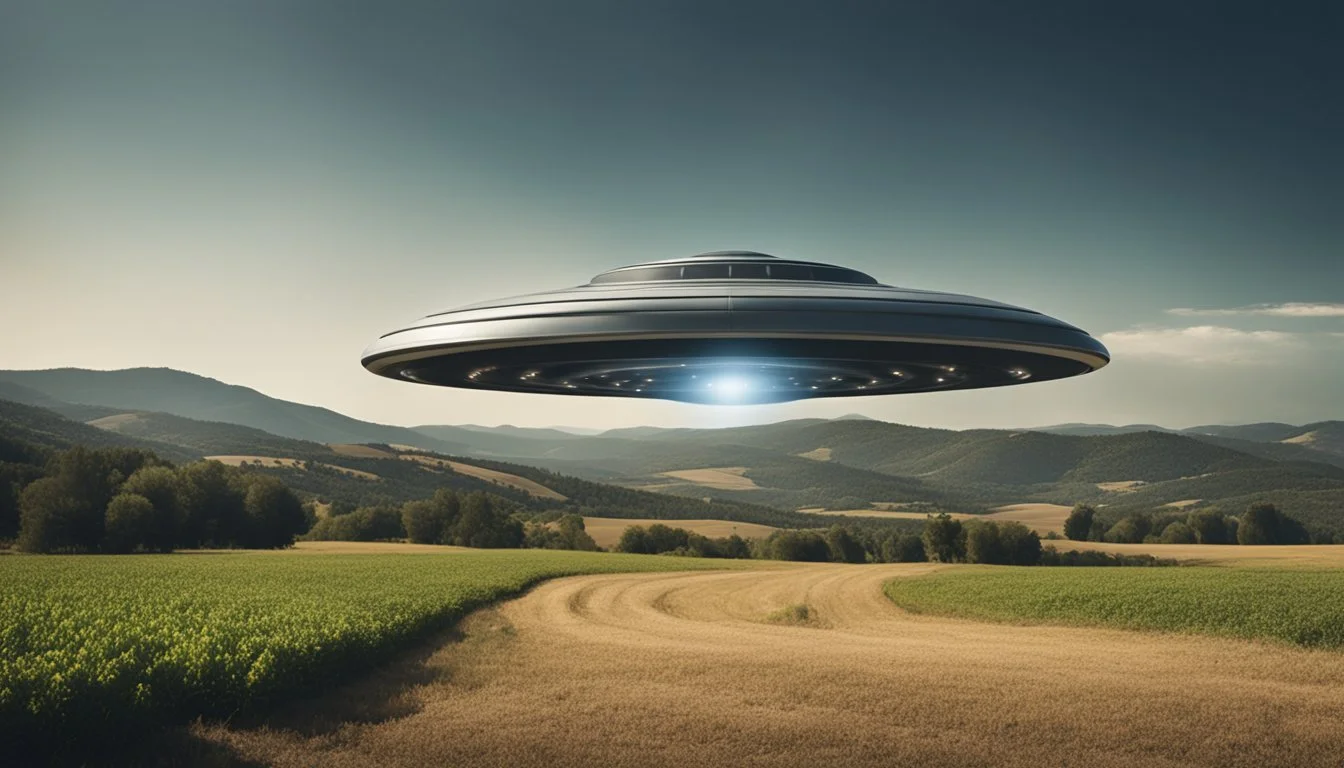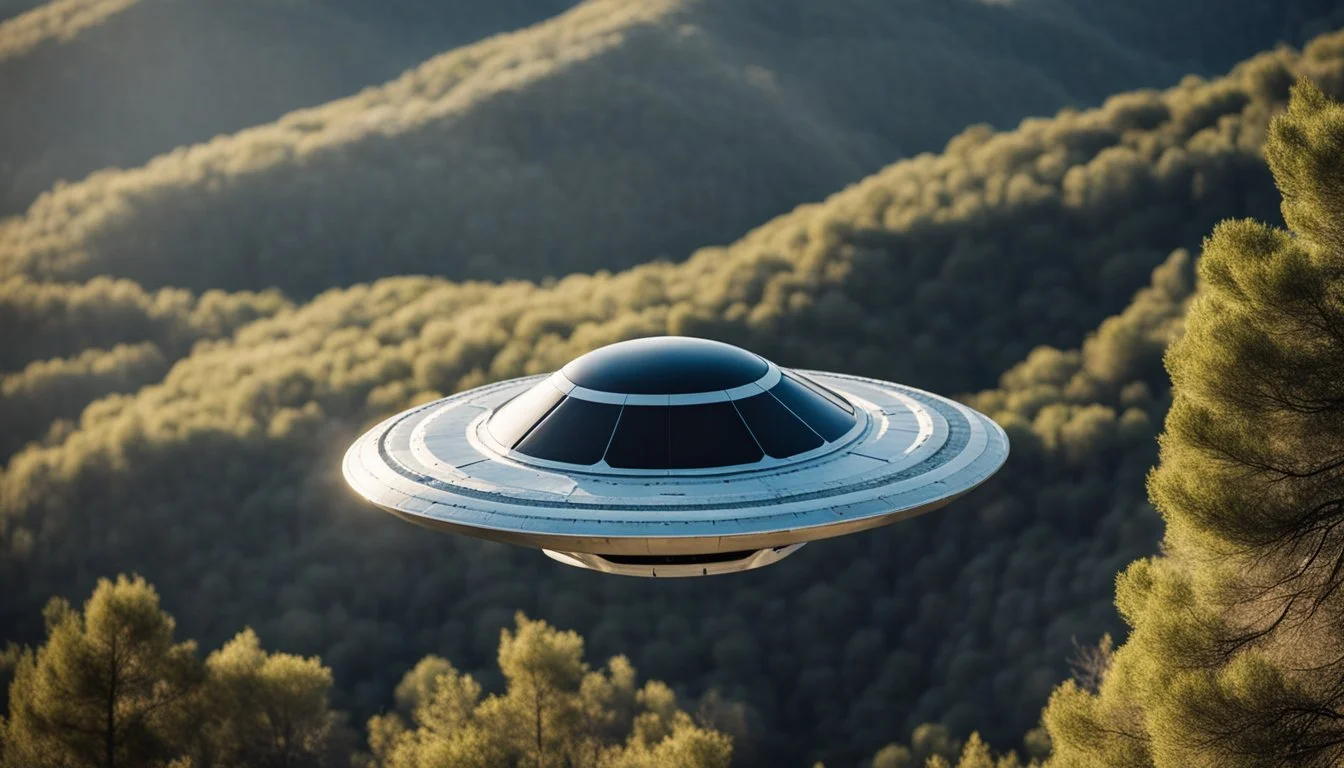The Fallen Angel of Catalonia
UFO Sighting Shocks Spanish Town
Spain has long been a hotspot for mysterious sightings and unexplained phenomena. Among these enigmatic occurrences, the Fallen Angel of Catalonia stands out as a particularly intriguing case. In 2006, a strange humanoid figure was reportedly captured on film in a Catalonian forest, sparking intense debate and speculation.
The creature, described as skeletal and possessing glowing eyes, has been dubbed the Fallen Angel of Catalonia by UFO enthusiasts and cryptozoologists. This sighting adds to Spain's rich history of UFO encounters and unexplained events, including incidents at military bases and regular sky-gazing sessions in Montserrat.
While skeptics argue for more mundane explanations, the Fallen Angel of Catalonia continues to captivate the imagination of those interested in extraterrestrial life and supernatural phenomena. The incident raises questions about the nature of reality and the possibility of otherworldly visitors to our planet.
Historical Context of Ángel Caído
The Ángel Caído monument in Madrid represents a unique blend of artistic vision and religious symbolism. Its creation and placement in the heart of Spain's capital city reflect the cultural and artistic trends of late 19th-century Europe.
The Legend of the Fallen Angel
The concept of the fallen angel stems from religious texts and folklore. In Christian tradition, it refers to Lucifer's expulsion from heaven. This powerful imagery inspired artists and writers for centuries.
John Milton's epic poem "Paradise Lost" vividly depicted the fall of Satan. The work greatly influenced Ricardo Bellver's sculpture. Milton's portrayal of Lucifer as a complex, tragic figure resonated with 19th-century Romantic sensibilities.
Ricardo Bellver and the Monument
Ricardo Bellver, a Spanish sculptor, created the Ángel Caído statue in 1877. He crafted the original version in plaster while studying in Rome. The sculpture's dramatic pose and emotional intensity garnered significant attention.
Bellver's work won acclaim at a national exhibition. This success led to the decision to cast the statue in bronze. The Spanish government commissioned the bronze version for display in Madrid.
Installation in Parque del Buen Retiro
The bronze Ángel Caído statue found its home in Madrid's Parque del Buen Retiro in 1885. The park, once royal grounds, had become a public space in the 19th century.
A fountain designed by Francisco Jareño surrounds the statue. The monument stands at 666 meters above sea level, a number associated with the devil in Christian tradition. This coincidence adds to the sculpture's mystique.
The statue's placement in a prominent Madrid park sparked debate. Some viewed it as a masterpiece of Spanish art. Others questioned the appropriateness of a fallen angel statue in a public space.
UFO Sightings in Catalonia
Catalonia has been a hotspot for UFO sightings in Spain, with numerous reports spanning decades. The region's diverse landscapes and historical significance have contributed to its reputation as a focal point for unexplained aerial phenomena.
Historical Accounts of UFOs in Spain
Spain has a rich history of UFO sightings, with over 80 cases published by the Defense Ministry. These reports span 33 years and cover 1,953 pages of investigations into strange lights and objects in the sky. The ministry's efforts to uncover the origins of these sightings have been extensive but largely inconclusive.
Catalonia features prominently in these reports, with its mountainous regions and coastal areas providing diverse settings for UFO encounters. The province of Tarragona, in particular, has been a hotbed of activity.
The Incident of the Fallen Angel
One of the most intriguing UFO-related events in Catalonia occurred on June 11, 2006. A strange humanoid creature was allegedly captured on film in a forest near the region. The footage, timestamped at 1:13 AM, shows a skeletal, anorexic-looking being with glowing eyes.
This incident, known as the "Catalonia Fallen Angel," sparked widespread interest in the UFO community. The creature's appearance raised questions about its origin and nature, fueling speculation about extraterrestrial visitation.
Official Investigations and Public Response
The Spanish government has taken UFO sightings seriously, conducting official investigations into many reported incidents. However, these probes have often failed to provide definitive explanations for the phenomena observed.
Public interest in UFOs remains high in Catalonia. Since 1977, enthusiasts have gathered at Montserrat for regular sky-watching sessions. The mountain's mysterious reputation and religious significance have made it a popular destination for those seeking unexplained phenomena.
Local authorities and scientific institutions have also played a role in documenting and studying UFO reports in the region. Their efforts have contributed to a growing body of data on unexplained aerial sightings in Catalonia.
Cultural Significance and Folklore
The Fallen Angel of Catalonia has become deeply woven into the cultural fabric of the region. This enigmatic figure bridges religious symbolism, alien mythology, and artistic expression in fascinating ways.
The Devil and Religious Interpretations
Some view the Fallen Angel sighting as a manifestation of Satan himself. This interpretation stems from biblical accounts of Lucifer's expulsion from Heaven. Religious scholars point to the creature's skeletal appearance and glowing eyes as evidence of demonic origin.
Local clergy have debated the theological implications. Some see it as a test of faith, while others dismiss it as mass hysteria. The incident has sparked renewed interest in angelology and demonology among the faithful.
Churches in Catalonia have reported increased attendance since the sighting. Many seek guidance on reconciling their beliefs with this unexplained phenomenon.
Alien Lore and the Fallen Angel Motif
UFO enthusiasts interpret the Fallen Angel differently. They see it as proof of extraterrestrial visitation. The creature's humanoid yet otherworldly appearance fuels speculation about alien biology.
Some theorists link the sighting to ancient astronaut hypotheses. They claim angels in religious texts were actually extraterrestrial beings. The Fallen Angel is seen as evidence supporting this view.
Local UFO groups have organized skywatching events in hopes of further sightings. The incident has become a cornerstone of Catalonian UFO lore.
Influence on Art and Literature
The Fallen Angel has inspired a wave of creative works. Painters depict the creature in haunting portraits, blending religious and sci-fi imagery. Sculptors craft eerie statues based on eyewitness descriptions.
Authors have penned novels and short stories exploring the incident's implications. These range from theological thrillers to alien invasion narratives. Poetry about the Fallen Angel often grapples with themes of faith and the unknown.
Filmmakers have produced documentaries examining the sighting. Dramatizations in TV shows and movies further spread the legend. The Fallen Angel has become a cultural touchstone, sparking creativity across artistic mediums.
Scientific and Skeptical Perspectives
Scientists and skeptics approach UFO sightings with rigorous analysis and alternative explanations. They examine evidence, consider psychological factors, and evaluate media influence on public perceptions.
Analyzing UFO Reports
Investigators scrutinize UFO reports using scientific methods. They analyze video footage, witness testimonies, and environmental data. Experts look for natural phenomena that could explain sightings, such as weather balloons, aircraft, or celestial bodies.
UFO researchers use image enhancement techniques to examine details in photos and videos. They consult meteorological records and flight logs to identify known objects in the sky. Some employ radar data to corroborate visual sightings.
Skeptics often point out the lack of physical evidence in most UFO cases. They argue that extraordinary claims require extraordinary proof, which is rarely provided in UFO encounters.
Psychological Explanations for Sightings
Psychologists suggest various factors that may contribute to UFO sightings. These include:
Misidentification of ordinary objects
Pareidolia (seeing patterns in random stimuli)
Suggestion and expectation
False memories
Stress, fatigue, and altered states of consciousness can affect perception. In some cases, witnesses may experience sleep paralysis or hypnagogic hallucinations, mistaking these for alien encounters.
Cultural influences and pre-existing beliefs about extraterrestrial life may shape how people interpret unusual experiences. The power of suggestion can lead groups to share similar misperceptions.
The Role of the Media in UFO Phenomenon
Media coverage significantly impacts public perception of UFOs. Sensationalized reporting can amplify interest and belief in extraterrestrial visitations. TV shows, movies, and books about aliens shape cultural expectations.
News outlets often prioritize dramatic UFO stories over mundane explanations. This creates a skewed representation of UFO incidents. Social media accelerates the spread of unverified claims and doctored images.
Some critics argue that media attention creates a feedback loop. Increased coverage leads to more reported sightings, which in turn generates more media interest. This cycle can perpetuate belief in UFOs regardless of scientific evidence.
Comparative Analysis
The Catalonia Fallen Angel sighting shares similarities with other supernatural encounters worldwide. Eyewitness accounts and cultural depictions offer intriguing parallels across different societies.
Fallen Angel Depictions Worldwide
Fallen angel imagery appears in various cultures. The Statue of the Fallen Angel in Madrid's Retiro Park depicts Lucifer's fall from grace. This 1877 sculpture by Ricardo Bellver is a rare public monument to the devil.
In Paris, gargoyles adorning Notre-Dame Cathedral include demonic figures reminiscent of fallen angels. These stone sculptures serve both decorative and functional purposes on the Gothic structure.
The concept of fallen angels features prominently in religious texts and folklore globally. In Christian tradition, Lucifer and his rebellious angels were cast out of heaven. Similar tales of divine beings falling from grace exist in Islamic, Hindu, and other belief systems.
UFO Encounters in Other Cultures
UFO sightings occur worldwide, with some resembling the Catalonia incident. In 1561, residents of Nuremberg, Germany reported seeing strange objects in aerial combat. This event, recorded in a broadsheet, describes shapes similar to modern UFO accounts.
The 1947 Roswell incident in New Mexico remains one of the most famous UFO cases. It sparked widespread interest in extraterrestrial visitations and government conspiracies.
Ancient rock art in Australia and India depicts mysterious flying objects, interpreted by some as early UFO sightings. These petroglyphs and cave paintings suggest a long history of unexplained aerial phenomena across cultures.
Conclusion
The Fallen Angel of Catalonia remains an enigmatic figure in Spain's UFO lore. This alleged cryptid sighting in 2006 near Catalonia sparked intrigue among paranormal enthusiasts.
The creature's humanoid yet skeletal appearance and glowing eyes set it apart from typical UFO reports. Its origins and nature continue to baffle investigators.
Spain has a rich history of UFO encounters, with sightings reported across the country. The Catalonia incident adds to this tapestry of unexplained phenomena.
While skeptics dismiss the Fallen Angel as a hoax or misidentification, believers see it as evidence of extraterrestrial or interdimensional visitors. The truth remains elusive.
This case highlights Spain's ongoing fascination with UFOs and paranormal events. It joins other notable incidents like the 1976 Talavera la Real Air Base encounter.
The Fallen Angel of Catalonia serves as a reminder of the mysteries that continue to capture our imagination. It underscores the enduring appeal of UFO studies in Spain and beyond.






